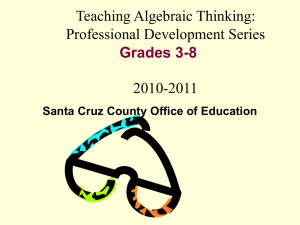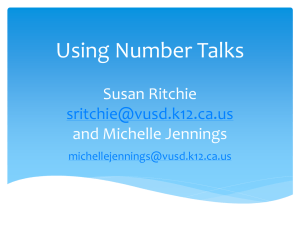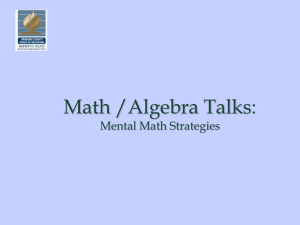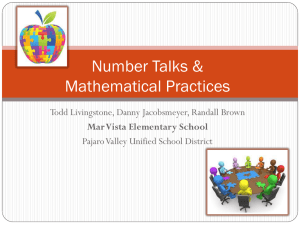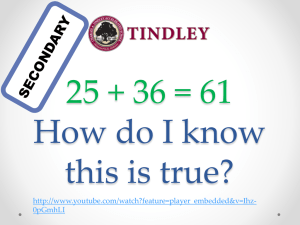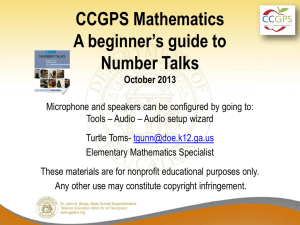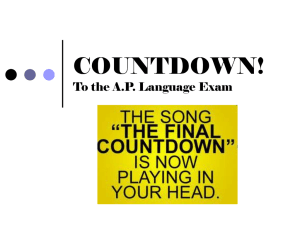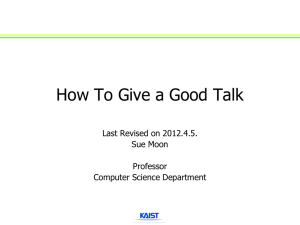File - 5th Grade Math Institute
advertisement
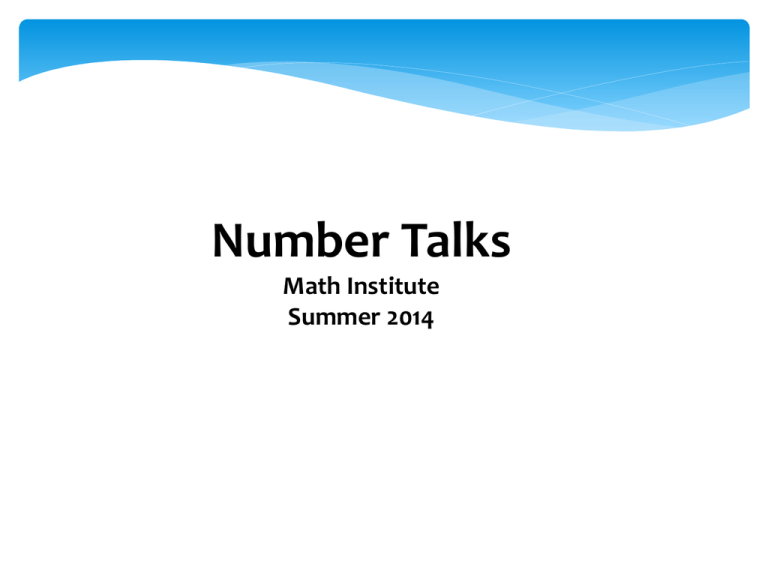
Number Talks Math Institute Summer 2014 Activating Strategy Discussion: Which common errors would you expect to see? 47 +38 51 -36 5+28+9+133 2 + 3 = ___ + 2 Students often do not bring number sense to the work. They need to be able to reason and solve mentally. On a scale of 1-4, decide where you are with Number Talks 1-Never heard of Number Talks before today 2-Heard of Number Talks, interested in learning more 3-Have tried Number Talks in my classroom 4-Regulary use Number Talks in my classroom and have either invited other teachers into my room to observe Number Talks or have taught staff development on Number Talks Now…Find the chart paper with the same number as your comfort level with Number Talks. 1’s-Write down questions you have. What do you really want to know? 2’s-What questions do you still have? What are your next steps and what is keeping you from diving deeper with Number Talks? 3’s-What has worked for you and not worked for you? What have you noticed about your students’ abilities to think and talk mathematically? What do you think is important to share with others? 4’s-What do you think are the most important things to share with teachers who are just starting out? What suggestions or helpful hints do you have to share? “Our classrooms are filled with students and adults who think of mathematics as rules and procedures to memorize without understanding the numerical relationships that provide the foundation for these rules.” - Number Talks Computation Progressions: Strategies (Student-Invented) Algorithms (Generalized Strategies) Standard Algorithms Turn and Talk: At which grade levels should standard algorithms for addition/subtraction with regrouping, multiplication, and long division be taught? Common Core Standards/AKS 2nd Grade 16.NBT.8 use mental math strategies to add and subtract 10 or 100 to a given number between 100-900 4th Grade 16.NBT.6 find whole-number quotients and remainders with up to four-digit dividends and onedigit divisors, using strategies based on place value, the properties of operations, and/or the relationship between multiplication and division. Illustrate and explain the calculation by using equations, rectangular arrays, and/or area models What is a “Number Talk”? A five to fifteen minute classroom conversation around purposely crafted computation problems that are solved mentally GOALS of a Number Talk: Accuracy Flexibility Efficiency By sharing and defending their solutions and strategies, students are provided with opportunities to collectively reason about numbers while building connections to key conceptual ideas in mathematics. Why Number Talks? Students have the opportunity to: 1. Clarify their own thinking. 2. Consider and test other strategies to see if they are mathematically logical. 3. Investigate and apply mathematical relationships. 4. Build a repertoire of efficient strategies. 5. Make decisions about choosing efficient strategies for specific problems Steps to Number Talks • • • • Present the problem Allow for quiet think time Thumbs up when ready Teacher records all possible solutions as dictated by the students • Students share their strategies (3-4) Classroom Clip Classroom Link: Before you watch this clip, think about how you would mentally solve this problem. 496 ÷ 8 Classroom Clip Classroom Link: Division String (Pg. 329 Number Talks Book) As you watch the clip, consider: 1. How does the succession of problems provide a scaffold for students to solve 496 ÷ 8? 2. How does this sequence provide multiple ways for students to access the problem? 3. In what other ways could 496 ÷ 8 be solved using the prior problems? 4. The teacher repeatedly asks students to explain where their answer is in their strategy. Why is this an important focal point throughout the discussion? Standards For Mathematical Practice Make sense of problems and persevere in solving them Reason abstractly and quantitatively Construct viable arguments and critique the reasoning of others Model with mathematics Use appropriate tools strategically Attend to precision Look for and make use of structure Look for and express regularity in repeating reasoning Five Small Steps 1. Start with smaller problems to elicit thinking from multiple perspectives. 2. Be prepared to offer a strategy from a previous student. 3. It is all right to put a student’s strategy on the back burner. 4. As a rule, limit your number talks to five to fifteen minutes. 5. Be patient with yourself and your students as you incorporate number talks into your regular math time. Summarizing • What benefits could you see from using Number Talks with your students? • What information do you feel that you will need before beginning Number Talks? • What questions do you still have?
